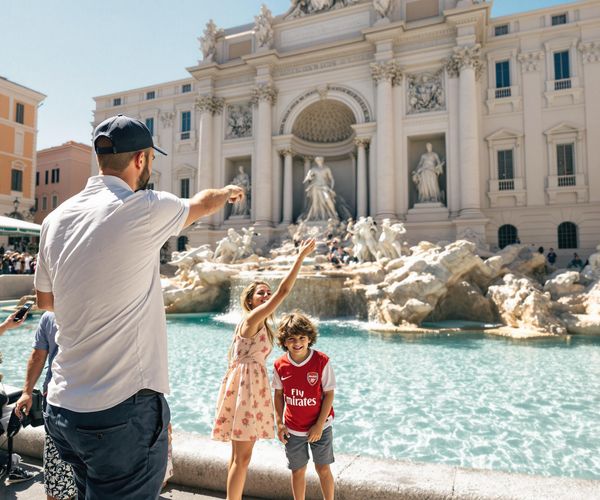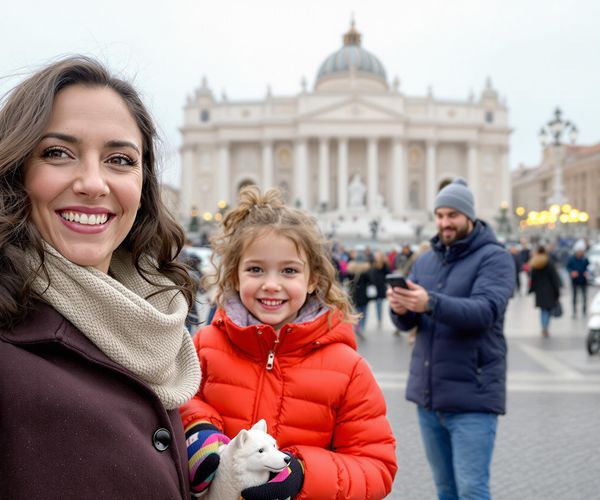Full day Rome Walking Tour in 6 Hours with Official Tour Guide
Highlights
- Walking tour of ancient Rome's imperial and roman forums
- Visit to the iconic Pantheon
- Exploration of the historic Piazza Navona
- Admiring the stunning Trevi Fountain
- Climbing the Spanish Steps in Piazza di Spagna
-
Duration 6 hours
-
Official Tour Guide
-
Private Tour Experience
-
Available in English
-
Admission Tickets Not Included
Experience the wonders of Rome in just 6 hours with our Full Day Rome Walking Tour. This immersive tour takes you to the iconic sites that make Rome famous, allowing you to truly capture the essence of this magnificent city. Starting from the Colosseum, you will be transported through time as you walk the ancient streets of Via dei Condotti and admire the majestic Flaminio Obelisk in Piazza del Popolo. As you continue on Via del Corso, you will reach Piazza Venezia, where you can explore sights such as the Vittoriano and the tomb of the Unknown Soldier. Your journey will also take you to the Area Sacra di Largo Argentina, the Pantheon, Piazza Navona, the Trevi Fountain, and the Spanish Steps. This tour is a comprehensive experience of Rome that will leave you with memories to last a lifetime.
At a Glance
-
Free cancellation
-
6 hours
-
Instant Confirmation
-
Available in English
-
Mobile voucher
-
Small Group tour
-
Guided
-
Family friendly
Explore Rome's iconic sites in a full-day walking tour with a professional guide, uncovering history and culture in just six hours.
Included
-
Official Tour Guide
Excluded
-
Transfer by taxi if you need it
-
Tickets
-
Private transportation
-
Lunch
Meeting Point
Your tour guide will have a signboard with your last name printed on it
Piazza del Colosseo, 00184 Roma RM , Italy
What to expect
Via dei Fori Imperiali
Your tour guide will take you on this nice walk in the middle of the ancient rome on via dei fori imperiali to enjoy the imperial forum and the roman forum.
Piazza Venezia
Is a central hub of Rome, Italy, in which several thoroughfares intersect, including the Via dei Fori Imperiali and the Via del Corso. It takes its name from the Palazzo Venezia, built by the Venetian Cardinal, Pietro Barbo (later Pope Paul II) alongside the church of Saint Mark, the patron saint of Venice. The Palazzo Venezia served as the embassy of the Republic of Venice in Rome. One side of the Piazza is the site of Italy's Tomb of the Unknown Soldier in the Altare della Patria, part of the Monument to Vittorio Emanuele II, first king of Italy. The piazza or square is at the foot of the Capitoline Hill and next to Trajan's Forum. The main artery, the Via di Fori Imperiali begins there and leads past the Roman Forum to the Colosseum. Capitalizing on this modern and ancient symbolism--and the useful open space--Piazza Venezia was the location of public speeches given by the Italian dictator Mussolini to crowds of his supporters in the 1920s-1940s.
Area Sacra di Largo Argentina
You'll be able to see the area where julio cesar was killed on March 15th in 44 B.C.
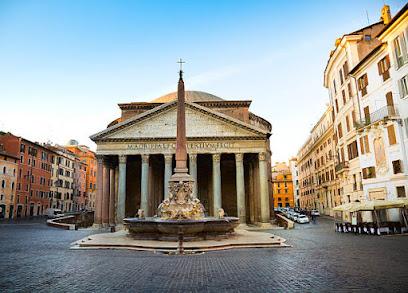
A pantheon is an overview of a given culture's gods and goddesses and reflects not only the society's values but also its sense of itself. A pantheon directed by a thunderbolt wielding autocrat might suggest a patriarchy and the valuing of warrior skills. A pantheon headed by a great-mother goddess could suggest a village-based agricultural society. To confront the pantheon of the Egyptians is to confront a worldview marked by a sense of death and resurrection and the agricultural importance of the cycles of nature. The Greek pantheon is a metaphor for a pragmatic view of life that values art, beauty, and the power of the individual, and that is somewhat skeptical about human nature.
Piazza Navona
Defined as a public space in the last years of 15th century, when the city market was transferred there from the Campidoglio, Piazza Navona was transformed into a highly significant example of Baroque Roman architecture and art during the pontificate of Innocent X, who reigned from 1644 until 1655, and whose family palace, the Palazzo Pamphili, faced the piazza. It features important sculptural creations: in the centre stands the famous Fontana dei Quattro Fiumi or Fountain of the Four Rivers (1651) by Gian Lorenzo Bernini, topped by the Obelisk of Domitian, brought in pieces from the Circus of Maxentius; the church of Sant'Agnese in Agone by Francesco Borromini, Girolamo Rainaldi, Carlo Rainaldi and others; and the aforementioned Pamphili palace, also by Girolamo Rainaldi, that accommodates the long gallery designed by Borromini and frescoed by Pietro da Cortona.
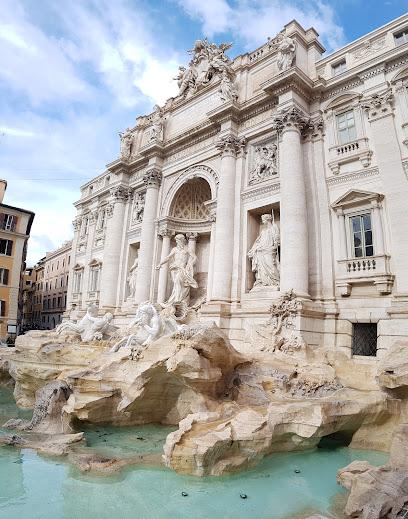
The Trevi Fountain (Italian: Fontana di Trevi) is an 18th-century fountain in the Trevi district in Rome, Italy, designed by Italian architect Nicola Salvi and completed by Giuseppe Pannini and several others. Standing 26.3 metres (86 ft) high and 49.15 metres (161.3 ft) wide, it is the largest Baroque fountain in the city and one of the most famous fountains in the world.
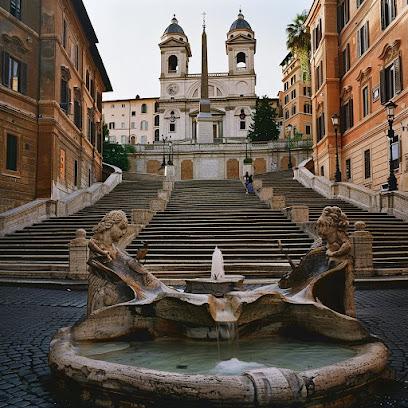
The Spanish Steps (Italian: Scalinata di Trinità dei Monti) are a set of steps in Rome, Italy, climbing a steep slope between the Piazza di Spagna at the base and Piazza Trinità dei Monti, dominated by the Trinità dei Monti church at the top. The monumental stairway of 135 steps (the slightly elevated drainage system is often mistaken for the first step) was built with French diplomat Étienne Gueffier's bequeathed funds of 20,000 scudi, in 1723–1725,[citation needed] linking the Trinità dei Monti church that was under the patronage of the Bourbon kings of France and the Bourbon Spanish Embassy at the top of the steps to the Holy See in the Palazzo Monaldeschi at the bottom of the steps. The stairway was designed by architects Francesco de Sanctis and Alessandro Specchi.
The experience can be subject to change due to bad weather or unforseen circumstances. We always endeavour to give you the best possible experience.
Additional Information
-
Infants and small children can ride in a pram or stroller
-
Not recommended for pregnant travelers
-
Not recommended for travelers with poor cardiovascular health
-
Not recommended for travelers with spinal injuries
-
Public transportation options are available nearby
-
Travelers should have at least a moderate level of physical fitness
What our experts say
-
Start early to avoid crowds.
-
Wear comfortable shoes for walking.
-
Visit nearby gelato shops after the tour.
-
Consider lunch at Piazza Navona nearby.
-
Bring a water bottle to stay hydrated.
More About this Experience
Introduction
Experience the wonders of Rome like never before with the Full Day Rome Walking Tour in 6 Hours. This captivating tour takes you through the ancient city's iconic landmarks and hidden gems, providing you with a comprehensive overview of Rome's rich history and culture. Whether you're a history buff or simply looking to immerse yourself in the beauty of this eternal city, this tour is the perfect choice.What to expect?
During this tour, you can expect to explore famous sites such as the Roman Forum, Pantheon, Trevi Fountain, and Piazza Navona, among others. Your knowledgeable and friendly tour guide will provide in-depth insights into each location, bringing history to life with intriguing stories and fascinating facts. As you stroll through the cobblestone streets of Rome, marvel at the stunning architecture and soak in the vibrant atmosphere of this enchanting city.Who is this for?
This tour is designed for anyone who wants to delve into the heart and soul of Rome. Whether you're a first-time visitor or a seasoned traveler, this experience offers something for everyone. History enthusiasts will be captivated by the ancient ruins and architectural wonders, while art lovers will relish the chance to witness masterpieces by renowned artists. Additionally, families, solo travelers, and groups of friends can all enjoy this tour together, making unforgettable memories along the way.Why book this?
Embark on this tour and unlock the secrets of Rome with the guidance of an official tour guide. Gain a deep understanding of the city's rich heritage and discover its hidden stories that are often overlooked by tourists. With a duration of 6 hours, this comprehensive tour ensures you'll see more than you ever imagined possible in a single day. Immerse yourself in the vibrant atmosphere of the city, admire the impressive architecture, and capture insta-worthy photos that will make your friends jealous.Good to know
During the tour, you'll have the chance to visit several iconic landmarks, including Via dei Fori Imperiali, Piazza Venezia, Area Sacra di Largo Argentina, Pantheon, Piazza Navona, Trevi Fountain, and Piazza di Spagna. Remember to wear comfortable walking shoes, as you'll be covering a significant distance on foot. Your tour guide will provide engaging commentary and answer any questions you may have along the way, ensuring you have a truly unforgettable experience.Reviews
This tour has received rave reviews from individuals who have experienced its magic firsthand. Visitors praise the knowledgeable and passionate tour guides who bring the history of Rome to life. Travelers appreciate the comprehensive itinerary, which allows them to see multiple famous sites in a single day. Many reviewers also highlight the convenience of hotel pickup and drop-off, making the tour hassle-free and enjoyable. Overall, customers express high satisfaction with the tour, often describing it as a highlight of their trip to Rome.Journals from our explorers at this location
This is a popular product and the date you are looking for just sold out. Next available date is




















